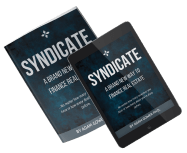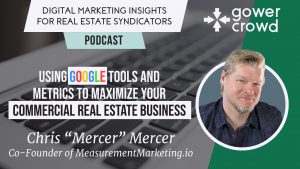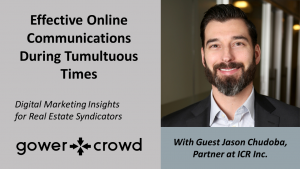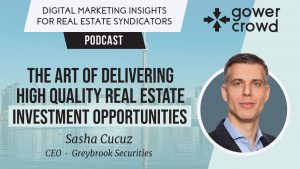Podcast Episode 314: Casey Zeman, Founder & CEO EasyWebinar
The Power of Webinars in Real Estate Finance

EasyWebinar is an online software platform for running both live and automated webinars/events.
Raising capital from investors online requires that you build a know, like and trust relationship with your prospects and that is what EasyWebinar was designed to do.
The conversation with Casey is packed with insights and practical suggestions for how to use the webinar tool to its best potential.
See below for more links to Casey.
What You're Going to Learn
* How to raise capital for your deal using webinars
* How to duplicate yourself with automated webinars
* The power of the webinar experience
* How to raise capital anywhere, anytime, from anyone
* Your can raise more by tracking investor interaction
* The book-a-call webinar machine
* Perfect pitching with webinars
* How to pitch your deal 'live' even while you sleep
And much, much more.
Listen To or Watch the Full Podcast Here
Show Highlights
Raising More by Tracking Investor Interaction
Adam Gower: The other thing that I like a lot that is, it seems to me, unique to webinars is the CTA, the call to action, that pops up at a very specific moment during the replay. Tell me a little about that. As you know, in my case, we're looking to raise capital from investors online, so it may be ... We've been playing with some classic digital-marketing techniques to create scarcity.
Casey Zeman: Yeah.
Adam Gower: For example, we'll put a deadline on a 10-percent pref, for example - 10-percent preferred return - and once we've sold 10 million of that, then it's down to eight percent. We're going to always shut that down on Saturday, or whatever it happens to be. We create that, but how does that work ... How does the timing of the CTA popping up work in the webinar?
Casey Zeman: They work really well. For live webinars, obviously, you can send a call to action at any specific point. Typically, you'd send it at the time that you're making the offer for a live webinar. For an automated webinar that's pre-recorded, you can schedule it to show up when you're also in that video making that offer. You can show it ...
Now the interesting thing about it is you can also track if people click on it, how many people see the offer, and all sorts of stuff. The data is really something that you want to look into when you start to ... EasyWebinar gives you all this data, where you can see who's showing up, how much are they watching, are they seeing the offer, or aren't they?
Typically, a lot of times people will throw away their entire webinar because of the problem of no sales, but no sales can oftentimes be because someone's not seeing the offer. It could be that you may open up the offer earlier; maybe you have to create an expectation for reasons why do they need to stick and stay to the very end of the webinar. If you see drop-off at any point, there are things you could do, refinements that you could tweak in a webinar to make it better, and make it a better experience, and get sales.
Adam Gower: Right. You just hit on something very important there that let's make sure we get perfectly clear. That is that the data that you provide tells somebody, or tells the sponsor, or the developer somebody signed up for a webinar. You know that ... Did they show up? Did they stay long enough to see the offer? Did they click on anything at the end?
Then, depending on how they behave and that data, you can then automatically send other emails to them. Somebody that stays all the way to the end, but doesn't click through to sign up, we can send them a different set of emails than somebody who doesn't show up - who registered but didn't show up.
Casey Zeman: Exactly.
Adam Gower: We could tell them, "See the replay."
The Book-A-Call Webinar Machine
Casey Zeman: For this specific type of person ... The people that you're looking to attract, they're high-profile. They are, you said, net revenue [cross talk]
Adam Gower: Right, accredited investors; high-net-worth [cross talk]
Casey Zeman: Exactly. You have to also think that their time is very valuable. I'm just going to share this very quickly. What I would do in that scenario is I would actually create a direct, on-demand, pre-recorded webinar that they hit the registration page, they can go directly to a replay of the presentation.
It's basically a kind of a replay page. That page has a 20-minute workshop; nothing more than 20 minutes, because you don't need an hour-long webinar for this scenario, because you're asking me what would be a typical webinar ... Well, webinars vary, based on who the audience is.
For you, it would be a 20-minute workshop that would be more like a video sales letter, really highlighting and touching on what the most important elements are, or why they need to show up, but in the webinar experience. Then, that is only available for three days. They can watch this on-demand workshop for three days, five days, what have you. The intention is to get them into a calendar to book them in a call and go through the process of seeing if they're the right fit.
When it comes to what a webinar experience should have, I teach a six-step framework in what webinars should have. I believe that a webinar needs to start off with having a buzz; people need- when they show up to the webinar, they need to know what's going to happen. You create this expectation and anticipation of what the webinar is going to be about, basically. right.
That's the first step. That's the first thing, because it's all about- you want to try to get people to stay on your workshop. You want them to stick around, so you have to create a stick factor, and that's going to be in that buzz, so that's the first thing.
The second thing is you want to then bridge from that into getting personal with your audience. Why are you here? Who are you to be talking about this? You're going to basically start to build a 'know, like, and trust.' You're going to outline the overall problem that they're having, and maybe an itch that they need to scratch.
A lot of people don't like to share their story, because they think that they need to rush and get to the meat of it, but the whole idea is the story- is that it provides ... You're relating to your audience through empathy. Your story and how you position it in a webinar isn't about you, it's about them.
They need to know that, while you're telling your story, it has to basically be like, "Oh, that's me! I'm in the same boat. Yes!" How I've been trying to find investors has not been necessarily easy. Yeah, I had to do the- signed up for the $50,000 a year, or $100,000 a year country club just to try to get into the right ..."
Adam Gower: Right.
Casey Zeman: You create these- you base your own experiences on your story, but with the idea and understanding that it's to relate to your audience, so they feel connected, and they basically start to say, "Oh, I've had the same thing."
What you're going to do at this point, when you start to get personal is, you're actually going to start to pepper this concept of the uncommon solution. The common solution, as we just said, is what people have been known for doing is going to country clubs, and doing all this, and it costs this. No guarantees ...
The uncommon solution is crowdsourcing. You start to pepper that ... "Nothing was really working until this wonderful opportunity of crowdsourcing came up ... This is how powerful it is." Then you start to share why that's powerful; why this whole crowdsourcing thing is-
Perfect Pitching With Webinars
Casey Zeman: A lot of people think that they have to give so much, in terms of what value is. Value is a-ha moments; they are moments where you have some sort of realization. It's a sales- yes, a webinar is a sales experience, but what I sometimes see people doing is they give away too much. They share too much. They bog their webinar down.
For a webinar, especially one that has a call to action for getting on a strategy call, 30 minutes ... It really should just highlight exactly what you said. Like you just said, oh, yeah, and you would lose it all, if you go on this one deal. That's how it used to be, but now it's changed, and that's good for you, right? As an investor, that's good for you. This is what it is.
You're positioning it ... That's what you're positioning. A webinar, again, in this scenario, should be probably more like a of a video sales letter, to a degree, that has a little more engagement. You can offer PDFs, something that they can download. Really, kind of hybrid, the idea of video sales letter, and the webinar together, and then you have this wonderful 30-minute experience. That's really what it should be.
Then, future pacing, you're going to want to share with them, like, "Imagine being able to go in not having to feel like you're losing your shirt, when you invest, or feeling confident that you're diversified." Future pacing simply means that you are ... Have you ever heard of 'future pacing,' by the way?
Adam Gower: No, I haven't, actually.
Casey Zeman: Future pacing is where you do a visualization exercise, where you show exactly- paint the picture of what could be. "Imagine in two years, you have- you've diversified, and you haven't gone in one project ... With that diversification, now, five years later, you're getting this net revenue ..." Future pacing basically is to get them poised to say this is the possibility.
Adam Gower: Right. Visualizing the world that could be, right?
Casey Zeman: Yeah, exactly, because that's what you're doing. You see something that's possible, where other people don't, and that's- you're going to resonate with the people that also see that this is the next- this is kind of where things are evolving, right?
Adam Gower: Yeah.
Learning How to Sell
Adam Gower: Let me ask you, how did you learn to sell? You said that you were bad, and then you got better. Obviously, you were iterating in some way. How were you doing that?
Casey Zeman: I realized that all of my anxiety about selling was my own, because people inherently want to buy from you. If you have a solution for a problem that they have, they're ready to take this- they're ready for the solution. You just have to let them know why, and how, and then that's really what you have to focus on. What's going to be the benefit to them?
I did really bad webinars when I started off, and even my bad webinars, once I started selling, I sold. I could make money. I remember one webinar I had, somebody - an affiliate - promoted it. This affiliate brought in maybe 300 people into the webinar. I was like, "Oh, my gosh!" It was crazy.
This webinar was done in the back farmhouse of my wife's parents place, which is in Iowa. It was this trailer with farmland all around. The internet was terrible. It was in the dead of winter. I had a heater blaring in the background, and I had my onboard microphone. I didn't even have anything fancy. No camera. It was just 4:3 PowerPoint slides.
All said and done, I did about $2,000 worth of sales on that webinar, and that's me sucking. That was me doing a terrible job. I realized at the time that webinars ... There is room for error because it's a human connection, and as long as you provide two things, you can succeed, even if you're a stutterer; even if you have fear of public speaking.
If you provide- if you have sincerity in what you're providing them - if you're sincere as a human - and then you provide value based on what your offer is, then you'll succeed. Those are the two things. Sincerity, being authentic, and then actually providing value, not just smoke and mirrors. You have to actually give value.
How to Duplicate Yourself With Automated Webinars
Casey Zeman: Anyway, as a course creator, I was doing okay, but I wanted something else. I started talking to some developers because I was interested in webinars, but the problem with webinars is I was still held to my own bandwidth. I was getting burnt out when I would do these live webinars. My voice would go hoarse, and I would just not be ... I would always have to be on, and I- you can't always be on.
I started talking to some developers about creating what we call today 'automated webinars,' and that's when I started talking to them about automating the process of the webinar experience.
An automated webinar is basically a pre-recorded video streamed in real time with the experience of live, but you're not having to be there. People can comment. You can have Buy Now buttons, PDFs, and all sorts of fun, interactive things show up. It's streamed in real time, so, if someone shows up late, they're missing part of that actual show.
What I wanted to do is basically duplicate me and create a business around this - something scalable. I talked to some developers to start building this platform, so they did. They built what was known- what was, at the time, Easy Webinar Plugin, which was a WordPress plugin, and it was only an automated-webinar system. That's all it was. That was back in 2013. We launched it probably in- later on that year, as the MVP - minimum viable product - and we just started selling it, and it was a WordPress plugin.
Then, as you well know, EasyWebinar is not that. EasyWebinar is a full blown SaaS webinar platform that has automation added to it. Because we started off as an automated platform - an automation system - we've built and crafted our journey so that we keep that as top of mind, but at the same time, we feel that engagement is so important.
The ideas that we've tried to perfect over the years - automating engagement through the automated webinar experience, but also, as you well know, EasyWebinar has its own livestream platform, as well. No latency, high definition ... Very similar to what Zoom will do. Four people in the room. It's going to be more like six coming soon. You'll be able to do meetings and all sorts of stuff, and you can run live webinars up to 2,000-plus attendees; then take that experience, and then put it into our automated-webinar system.
It's a very cool way of leveraging webinars from live webinars to automated to grow your business. That's what we believe in. We believe that webinars are the one thing that will bridge that connection and sell.
The Power of the Webinar Experience
Adam Gower: The first question, I suppose, is let's make the distinction between what is a webinar, and why not just lob up a video on YouTube and say, "Go watch this"? What is the difference, then, between-
Casey Zeman: A webinar has ... Because it's an experience where people have to show up at a specific time [inaudible] be there, ready to go, it has more of a ... There's a higher value, I guess, perception of value in that. A replay video, anyone can go to a replay video, but a webinar, it's at a specific time. There's just more of that "This is important. I need to show up" sort of experience. Does that make sense?
Adam Gower: Yes, it sure does.
Casey Zeman: The video, it just ... Again, people can come in; they can leave. It doesn't have that same level of value or impetus to stick around. A webinar, it's because it can be scheduled in the future, it just has that higher perception of value than a video alone.
Adam Gower: There are two different types, aren't there? There's the evergreen, and then there's also the live. Tell me the difference between those two.
Casey Zeman: A live webinar is where you are doing, similar to this, where you are speaking to an audience, whether it's you in front of a camera sharing your value, or it's you sharing 16:9 PowerPoint presentation.
There's a lot of different ways people use webinars. Some people use them to get four people in a room or more and do a roundtable discussion. The concept of webinars can can be anything you want it to be, where it's an interactive experience.
A lot of people, unfortunately, they keep it in this little box of- you think of 4:3 PowerPoint slides, and that's it. But, no, no, no, it's a point in which you can engage, teach, and resonate with an audience. That is the power of it.
The other thing about a webinar that we see is that when we talk about webinars, we also want to look at webinars as more of an experience for sales. Probably a lot of people have heard of sales funnels, but what we like to focus on is sales experiences that have a higher engagement level. That's really what we find that webinars fulfill.
Raising Capital Anywhere, Anytime, From Anyone
Casey Zeman: If you need to connect, and resonate, and sell your products and services, or onboard customers, live webinars are really powerful. The other side of that is automated webinars, which you and I, we were just talking about, automated webinars are pre-recorded video content.
Now, the cool thing about an automated webinar is that you're not held to your own bandwidth. An automated webinar can stream multiple times during the day in your attendee's local time zone, which, if you have a worldwide audience, it's really difficult to run a live webinar.
Someone in Australia, or wherever in the world, it might be their early morning, let’s say, or their late evening. They might be in bed. The cool thing about an automated webinar is it gives opportunity for more registrations; more people coming through. It'll stream an event with the experience of live without you having to be there.
The thing that no one tells you is that an automated webinar is basically a sales funnel, but it's more of a sales experience. The key to it is to keep a continuity in your marketing from top of the funnel down. As an example, inside an EasyWebinar ... EasyWebinar, the platform, it has all the pages of what you want a webinar to have, but also, what a funnel should have.
It has a registration page, a thank-you page, a countdown page. The event page has all the emails to notify you of the event, post notifications to try to close the sale, where you then maybe send to a replay page. We have a timed replay page, where you can actually have a countdown timer on that page that will count down til the offer and the page expires. You create urgency. You create scarcity.
You can do all of this in a evergreen scenario; evergreen meaning that everyone who comes into it has their own unique experience. They feel like they're coming in, and, "Oh, this is catered specifically to me." That's really the power of it.
Adam Gower: Isn't that interesting? That's really interesting, because that's one of the key drivers to creating that relationship is that it doesn't feel necessarily automated or at least at the point that you've stopped automating, and you want to communicate directly with your customer. The webinar provides that, yet it is automated; at least the potential is for it to be automated.
Pitch Your Deal 'Live' Even While You Sleep
Casey Zeman: The idea behind an evergreen webinar ... You can run this live, or you can run it as automated, or evergreen. Automated, and evergreen, by the way, mean basically the same thing. Evergreen simply means that it's something you have running all the time, and it's a unique experience to that person, that individual.
An automated webinar, they're basically the same thing, but you can schedule EasyWebinar to do an automated webinar at one specific date - once a month - you know what I mean? It can be used like it's a live webinar, but typically, people use the automated-webinar element of EasyWebinar as more of an evergreen sales tool. Driving Facebook traffic, or LinkedIn traffic all the time to that funnel - that registration page of the webinar.
Adam Gower: Got it. Interesting. The idea of the evergreen is that it's automated, but it has the ... Anybody that enters the funnel, who registers, gets that webinar delivered to them exactly three days later, or one day later, or 15 minutes later. It seems very personal to them, but everybody's getting it in the same way, depending on when you enter the funnel.
Casey Zeman: We're using automated, and evergreen kind of interchangeably, basically.
Adam Gower: One thought that I've had, that I haven't done, because the idea ... Look, I'm quite happy chatting with you. I'm quite comfortable doing that. The idea of advertising and doing a live webinar ... I'm actually giving a presentation tomorrow to the Home Builders Association. They've invited me back.
Casey Zeman: Nice.
Adam Gower: I'm having somebody record it. I'm actually having somebody come out and video it, because if I stand in front of a video, instead of my camera, now, if you weren't there, and I was trying to do some ... I'm all kind of tongue-tied [cross talk] zero personality, right? [I add nothing to it ...]
When I'm in front of a crowd, or in front of somebody, I have some energy. So, one thought that I've had is - and do people do this? - where you maybe do one live one, and then use that later as evergreen, and then show up for the Q&A. You know it's running, let's say, at 10:00 a.m. every Monday morning and at 11:00, it switches over to Q&A. You can do that, as well, can't you, so there's a live interaction?
Casey Zeman: You can do that. Oh, for sure, yeah. You can do that. That's called a hybrid webinar. You can run a hybrid where maybe you even show up live in it, right away, and then pivot- then you press the button, and it plays the pre-recorded session that you've done. Then, come back in, in an hour, when you're about to toggle over to the Q&A part, and just ... You can even be in the chat while that video is playing.
Related to this episode:














